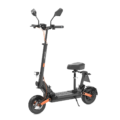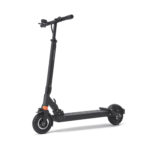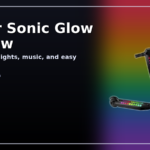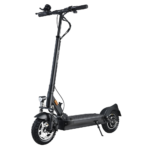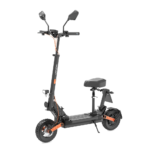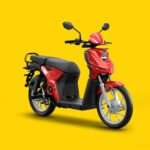- Home
- Scooters
- Electric Scooters
- JOYOR T10
JOYOR T10
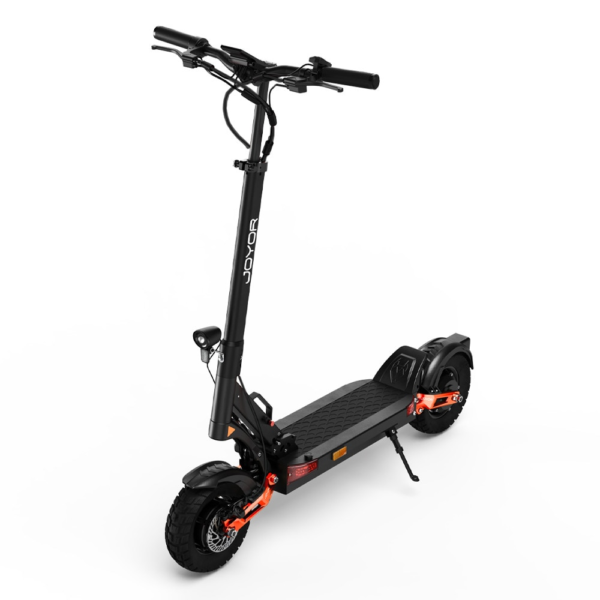

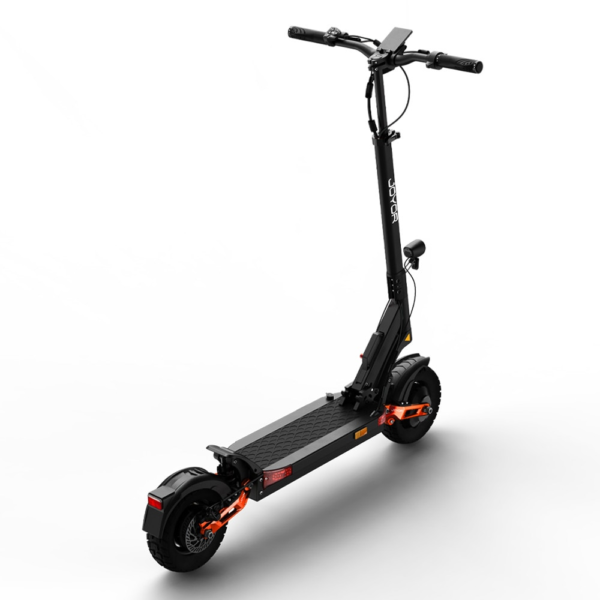

- Battery Range: 37–50 mi (60–80 km)
- Top Speed: 25–31 mph (40–50 km/h)
- Motor Power: 800–1000 W nominal
- Weight Capacity: 265 lb (120 kg)
- Charging Time: ~7–9 h
- Scooter Weight: 57.3 lb (26.0 kg)
PROS
- Sporty handling with stability
- Strong brakes and grip
- Long-range battery options
- Quick folding for storage
- Bright, commuter-ready lighting
CONS
- Heavier than mid-tier models
- Pneumatics require routine checks
- Top speed may be capped legally
- Firm feel on cobbles at high PSI

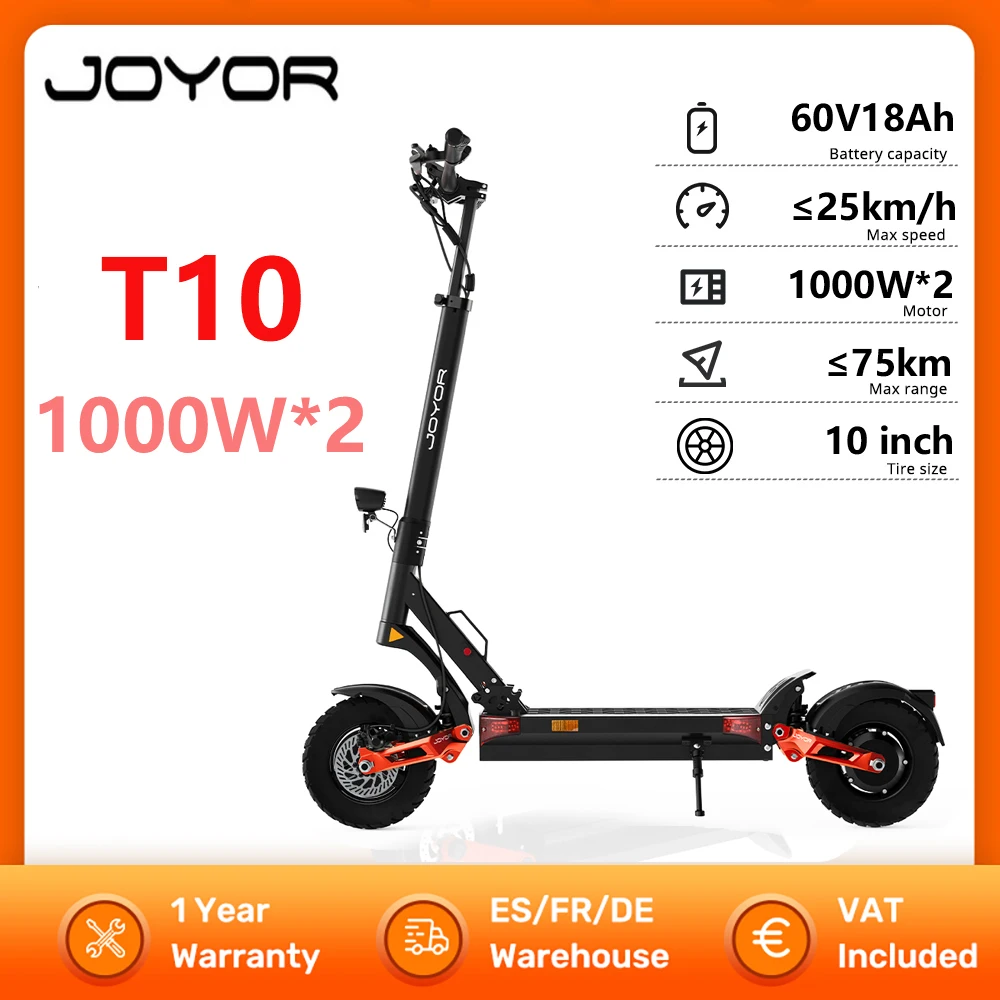

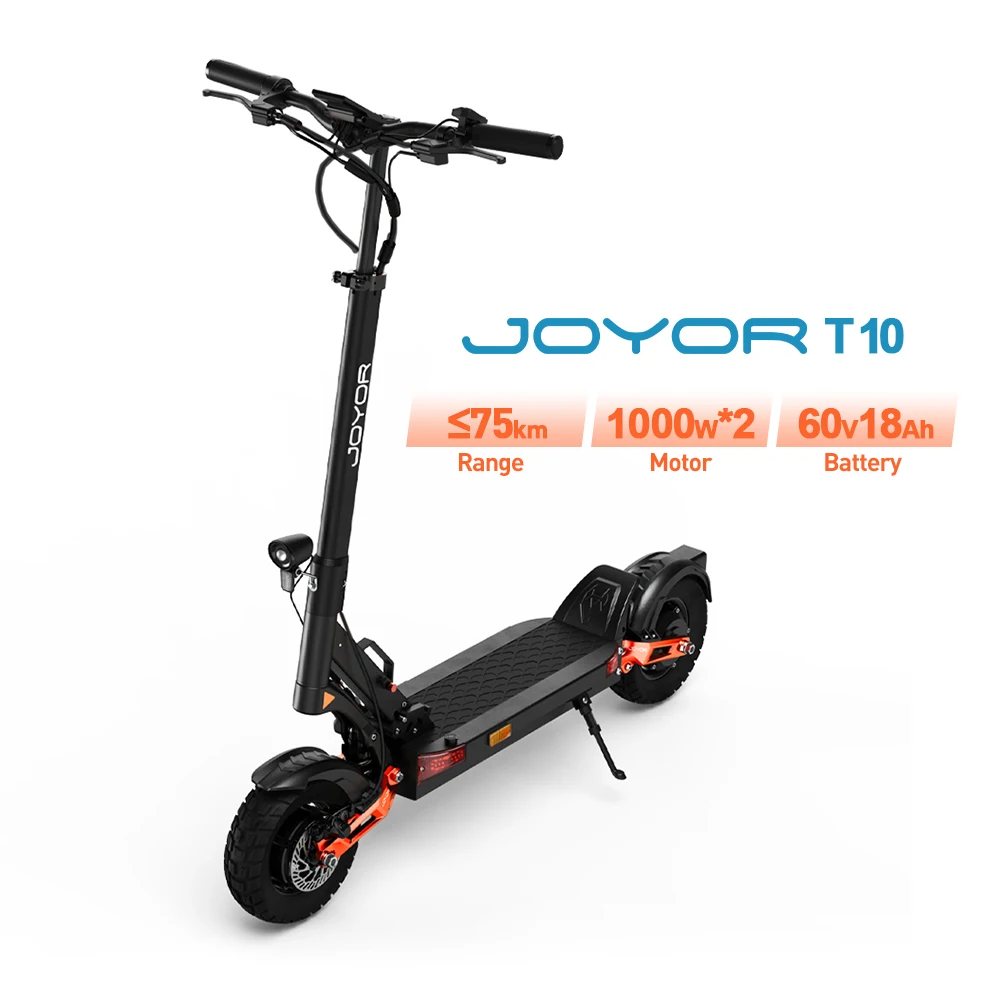


Table of contents
- What Is the JOYOR T10?
- How the JOYOR T10 Works
- Key Specifications
- Design & Build Quality
- Performance Fundamentals
- Battery, Range & Efficiency
- Ride Quality & Comfort
- Braking & Safety Features
- Portability & Daily Usability
- Maintenance & Care
- Weather & Seasonal Considerations
- JOYOR T10 vs Alternatives
- Who the JOYOR T10 Is (and Isn’t) For
- FAQs
- Glossary
- Final Thoughts
If you want a scooter that rides with purpose, the JOYOR T10 deserves a close look. It sits between commuter and performance classes, offering robust power, larger wheels, and a confident stance without going full “monster scooter.” Moreover, riders who want a stable daily machine—yet still enjoy spirited weekend rides—will appreciate how the JOYOR T10 balances range, comfort, and control in one package.
The JOYOR T10 is designed for people who value practical speed, predictable handling, and straightforward maintenance. While it has sporty intent, it stays approachable for intermediate riders and ambitious beginners who learn quickly. As a result, it suits commutes, campus travel, and medium-length urban trips just as well as relaxed neighborhood loops.
What Is the JOYOR T10?
The JOYOR T10 is a mid-to-upper-tier electric scooter built for riders who want more stability and acceleration than typical entry-level models. It typically features a reinforced frame, large pneumatic tires, responsive brakes, and an electronics package that feels confident in traffic. Consequently, you’ll notice its stance first: the deck is spacious, the stem looks solid, and the cockpit has an organized layout that keeps essential controls within easy reach.
Because it aims at the “practical performance” sweet spot, the JOYOR T10 favors predictable power delivery over dramatic surges. It accelerates briskly, holds cruising speed with minimal fuss, and maintains composure when the road surface gets rougher. In other words, it is not a track toy. Instead, it is tuned for repeatable daily use with enough enthusiasm to keep rides interesting.
Who Will Appreciate It Most
- Daily riders who want a step up from basic commuter scooters.
- Students and multi-modal travelers who need a capable yet manageable machine.
- Newer riders ready to move beyond beginner models, with sensible safety habits.
- Experienced riders seeking a reliable, lower-maintenance second scooter for errands.
How the JOYOR T10 Works
Electric scooters are simple at heart, and the JOYOR T10 embraces that simplicity with well-chosen parts that work together smoothly. Therefore, understanding how the main systems interact helps you ride more confidently.
Motor & Controller
The hub motor sits in one of the wheels (some trims offer a second motor). The motor converts battery power into rotation. Meanwhile, the controller acts as the scooter’s “brain,” regulating how much current reaches the motor. Think of the controller as a skilled barista who never overfills the cup: it meters power precisely to match your throttle input, temperature conditions, and the selected ride mode.
Because the controller smooths current delivery, the JOYOR T10 tends to avoid jerky starts. Instead, it rolls forward with steady torque. On steeper blocks, it keeps pulling as long as you hold the throttle, though real-world performance will always depend on rider weight, wind, and grade. Consequently, picking an appropriate mode for the terrain pays off.
Battery & BMS
The battery stores energy and sits inside the deck or frame cavity. A battery management system (BMS) protects it from over-charging, over-discharging, and excessive current draw. Additionally, when you charge, the BMS balances cell groups to prolong pack life. As long as you keep charge habits reasonable—such as avoiding prolonged 100% storage—the pack should deliver many cycles of consistent output.
Throttle & Display
The thumb or trigger throttle tells the controller how fast you want to go. The display shows speed, remaining charge, and ride mode. Moreover, buttons near the display let you scroll settings, toggle lights, and, in some configurations, enable or adjust cruise control. Because everything sits within thumb reach, you can make quick changes without taking a hand off the bars.
Brakes & Regen
The JOYOR T10 typically features mechanical or hydraulic disc brakes. Some trims include electronic regenerative braking, which uses the motor to slow the scooter and recover a bit of energy. Mechanical braking provides the primary stopping force; regen helps settle speed and reduces pad wear. On dry pavement, the levers produce a firm, progressive feel. With a light touch, you can trail brake into turns and stabilize the chassis. Nevertheless, in the wet you should brake earlier and more gently.
Key Specifications
The entries below describe the platform in practical, rider-focused terms. Exact figures vary by trim and region.
| Block | Details |
|---|---|
| General | Category: practical performance scooter; Use case: daily commuting with weekend fun; Deck: spacious stance for staggered foot placement; Ride modes: multiple options for power and efficiency; Lighting: integrated headlight and tail/brake light. |
| Performance & Power | Drive: rear hub motor on most trims; some versions add a front motor; Power delivery: smooth launch with steady mid-range pull; Top-end: tuned for urban speed limits and traffic flow rather than extreme racing. |
| Battery, Charging & Electrical | Battery: lithium-ion pack managed by a protective BMS; Charging: standard charger included; Optional faster charging may be supported—confirm with your model’s documentation; Ports: charge port with protective cap; Electronics: display with speed, mode, and remaining charge. |
| Build & Dimensions (folded included) | Frame: reinforced alloy construction; Tires: large pneumatic class for shock absorption; Suspension: front and rear for bump compliance; Fold: stem locks down for transport; Folded footprint: compact length and reduced bar height for car trunks and hallway storage. |
| Safety & Control | Brakes: mechanical or hydraulic disc braking; Regen: available on some trims for smoother deceleration; Traction: large tires improve grip and curb compliance; Visibility: bright headlight plus tail/brake light; Water resistance: basic splash protection; ride prudently in wet conditions. |
| Features & Extras | Cruise control: present on many trims and user-switchable; Cockpit: organized display and mode buttons; Kickstand: stable, wide foot; Reflectors: side and rear placements; Bell or horn: handlebar-mounted. |
| Warranty & Compliance | Warranty: varies by region and seller—retain proof of purchase; Compliance: follow local PLEV/e-scooter rules; Manuals: keep the user guide for torque specs, fuse info, and service intervals. |
Design & Build Quality
The JOYOR T10 presents itself as a serious piece of hardware. The frame tubing is robust, welds are tidy, and the folding joint looks engineered for repeated use. Furthermore, fit-and-finish tends to be consistent, with panels sitting flush and cables routed cleanly along the stem and into the deck.
Frame & Deck
The chassis prioritizes torsional stiffness. You can feel it during quick left-right transitions, where the deck resists twist and keeps your inputs precise. Additionally, the deck offers comfortable space for a staggered stance. This position reduces fatigue because you can brace your rear foot and relax your front ankle while absorbing bumps.
Stem & Folding Joint
The stem is substantial, and the folding mechanism closes with a committed, positive action. When locked, there is minimal fore-aft movement. Under heavy braking, the assembly feels composed rather than clattery. That said, every folding mechanism requires periodic inspection. Accordingly, adding a quick weekly check for latch tension and hinge hardware will keep the joint quiet and secure.
Cockpit Layout
The handlebar is wide enough for leverage yet narrow enough to slip through bike lanes and building doors. Grips have a supportive profile, and the throttle sits where your thumb naturally lands. Crucially, the brake levers line up with a straight wrist angle, which makes it easy to apply strong, progressive pressure without strain. Likewise, the display is legible in daylight and doesn’t wash out under streetlights.
Performance Fundamentals
Performance is not just about top speed. The way a scooter responds to the first quarter-turn of throttle matters more in everyday riding. Here the JOYOR T10 shines, because it delivers usable torque without the abrupt snap that can surprise newer riders. Consequently, it encourages precise control instead of brute force.
Acceleration Feel
From a standstill, the scooter rolls rather than leaps. As the speed builds, torque remains steady so you can merge into traffic calmly. On clean, dry pavement, the rear tire hooks up well. If you accelerate across a painted crosswalk or a metal plate, you’ll feel the tire skate slightly; a gentle wrist compensates instantly. Moreover, keeping your weight centered improves traction and stability.
Cruising Stability
Once at pace, the chassis feels planted. The wheelbase and geometry produce a settled, predictable line. With hands lightly on the grips, the scooter tracks straight, and small bumps don’t kick the front wheel off course. Therefore, you can ride one-handed briefly to signal or adjust a zipper, although both hands on the bar are always safer.
Hill-Climb Behavior (~7–10% Grades)
On moderate urban hills, the JOYOR T10 sustains speed respectably, especially in higher power modes. Starts on an incline are composed as long as you nudge the scooter forward before applying stronger throttle. On extended grades, speed will taper as expected; lighter riders retain a stronger pace while heavier riders benefit from selecting the most powerful mode and maintaining momentum. Even so, planning ahead and preserving rolling speed makes the climb smoother.
Battery, Range & Efficiency
Real-world range depends on speed, weight, wind, elevation, and temperature. The JOYOR T10 handles these variables with a battery sized for everyday city use. Nevertheless, technique and conditions still matter.
Rated vs Real-World
Manufacturer ratings assume steady speeds, mild weather, and a lighter rider. In practice, your results will vary. If you ride briskly with frequent starts, expect less. If you cruise smoothly in an eco mode, you can approach the optimistic end of the range window. In short, riding style strongly influences outcomes.
What Affects Range Most
- Speed: Air resistance grows quickly; small speed drops can add many city blocks.
- Weight: Heavier riders, backpacks, and accessories all increase demand.
- Temperature: Cold reduces available capacity; hot weather triggers protective limits.
- Terrain: Hills tax the battery; long downhills partly offset the loss with regen.
- Tire Pressure: Under-inflation increases rolling losses and dulls handling.
Charging Best Practices
- Charge partially for storage. Park the pack in the middle—roughly half full—if you won’t ride for a week or more.
- Avoid prolonged 100%. Top up to full right before a ride rather than the night before.
- Let it cool before charging. After a hard ride, give the pack time to reach room temperature.
- Use the supplied charger. Faster chargers are convenient, but they add heat; use them sparingly.
- Keep the port clean. Close the rubber cap and inspect for debris or moisture.
Ride Quality & Comfort
Comfort depends on three things: tires, suspension, and ergonomics. The JOYOR T10 scores well across all three. Additionally, its geometry encourages relaxed, confident control.
Tire Type & Pressure
Large pneumatic tires soak up cracks and joints that would rattle a solid-tire scooter. They improve grip on real streets, too. Check pressure weekly. With pressures in the recommended range for your weight, the tire sidewalls flex predictably and maintain a generous contact patch. Over-inflation reduces grip and increases chatter; under-inflation dulls steering and risks pinch flats. Therefore, a small pressure gauge becomes a valuable tool.
Suspension Behavior
Front and rear suspension take the edge off potholes and keep the chassis calm through choppy patches. You can feel the fork and rear unit working together: they compress as a pair over speed bumps and reset quickly without a pogo effect. If you bounce the deck by hand while stationary, the return feels controlled. Consequently, long urban rides remain comfortable.
Ergonomics & Stem Flex
The stance is upright but athletic. The stem exhibits modest, normal flex under heavy braking and quick swerves, which helps absorb shocks instead of transmitting them to your wrists. Crucially, the flex never feels vague or wobbly. If you do sense play at the hinge, check latch tension and fasteners immediately. Likewise, tightening loose accessories prevents distracting buzzes.
Braking & Safety Features
Stopping quickly—and stopping in control—matters more than any headline performance figure. Accordingly, the JOYOR T10 prioritizes predictable braking behavior.
Brake System & Feel
Mechanical discs offer solid bite and predictable modulation; hydraulic systems, when fitted, add lighter lever effort and more consistent feel during long descents. On dry pavement, the front brake provides the bulk of stopping power while the rear stabilizes the chassis. In wet conditions, initial bite is softer. Squeeze earlier and allow extra distance. Furthermore, practice emergency stops in a safe lot to learn your limits before you need them.
Electronic Regen
If your trim includes regen, you’ll notice deceleration the moment you roll off the throttle or apply a light lever pull. This smooths speed changes and extends brake pad life. On slick surfaces, keep regen conservative since it can cause a light, straight-line slip if set aggressively. Nevertheless, used moderately, it makes everyday speed control easier.
Lights, Reflectors & IP Considerations
A bright headlight improves conspicuity and illuminates the lane ahead. The tail light brightens during braking. Side reflectors add passive visibility at intersections. Regarding water, the scooter offers basic splash resistance. Puddles and heavy rain add risk: traction drops, and electronics dislike standing water. Therefore, reduce speed and skip deep puddles entirely.
Portability & Daily Usability
You judge a scooter not only by how it rides, but also by how it lives in your routine. The JOYOR T10 fares well here, too.
Weight and Carry Points
The JOYOR T10 sits in the mid-weight category. You can lift it up a few stairs or into a trunk, though carrying it long distances is tiring. The stem and deck provide sensible carry points; keep the front wheel pointed away from your legs to avoid bumping the tire while walking. Additionally, using gloves helps with grip if you carry it often.
Fold Mechanism & Storage
The folding system closes in seconds once you learn the sequence. The stem locks to the deck for transport, and the folded footprint fits in standard car trunks and building closets. For apartment storage, place a floor mat under the wheels to protect floors and catch any moisture. Meanwhile, keeping the scooter near room temperature benefits the battery.
Security Habits
Always lock through the frame to a fixed anchor, and choose a hardened lock. If possible, remove accessories like phone mounts when parked. At home, store the scooter indoors and away from high humidity or heat. In addition, mark your charger with your name to avoid mix-ups in shared garages.
Maintenance & Care
A little routine care goes a long way. Here’s a simple, realistic plan that keeps the JOYOR T10 smooth and quiet. Importantly, most steps take only minutes.
Quick Weekly Checks (5–10 Minutes)
- Tire pressure: Set to the recommended range for your weight.
- Brake feel: Squeeze levers; look for firm engagement without grittiness.
- Hinge & latch: Inspect for movement; adjust tension if needed.
- Lights: Confirm headlight and tail/brake light function.
- Fasteners: Spot-check stem clamp, axle nuts/bolts, and fender mounts.
Monthly Tasks
- Brake pad inspection: Replace when thin or glazed; bed new pads with a dozen strong stops.
- Rotor cleaning: Wipe with isopropyl alcohol; avoid touching with greasy fingers.
- Suspension wipe-down: Keep dust off seals; inspect for leaks or damage.
- Cable and hose routes: Ensure no kinks or rubbing points have developed.
Every Few Months
- Deck opening (if comfortable): Check for moisture; confirm connectors are tight.
- Battery health review: Note range trends; large, sudden drops may indicate issues.
- Firmware/app habits: If your trim supports updates, apply only official releases. Additionally, avoid beta firmware on a daily rider.
Storage Tips
- Dry environment: Avoid basements with standing humidity.
- Half-charge for long pauses: Ideal for pack longevity.
- Away from sunlight: UV can degrade plastics and heat the pack unnecessarily.
- Clean before storage: Dirt holds moisture; a quick wipe prevents corrosion.
Weather & Seasonal Considerations
Weather shapes traction, range, and comfort. Ride technique and planning make the difference. Therefore, adjust your habits as conditions change.
Rain
Wet roads cut grip. Therefore, slow down, brake earlier, and keep movements smooth. Paint, metal plates, and leaves become slick. Tires clear water better at moderate speeds than at crawling pace, but you should still minimize lean angles and avoid sudden throttle changes. Additionally, dry your rotors with a light brake drag after puddles to restore bite.
Cold
Cold temperatures reduce available battery capacity and make rubber less pliable. Expect shorter range and firmer ride feel. Pre-warm the scooter indoors when possible, and charge at room temperature. Additionally, consider slightly lower tire pressures within the safe range for added grip. A thin glove liner under riding gloves keeps fingers nimble for braking.
Heat
Heat improves capacity but can stress the pack if you ride hard and then immediately charge. Let the scooter cool before plugging in. Hot asphalt can soften rubber; monitor tire wear more frequently during heat waves. Moreover, store the scooter out of direct sun to protect plastics and the battery.
JOYOR T10 vs Alternatives
The market spans commuters, performance machines, and off-road-leaning models. The JOYOR T10 occupies a versatile middle ground. Consequently, the best choice depends on your route, storage, and appetite for speed. Alternatively, if you want a similarly sized platform with more assertive dual-motor tuning, consider the JOYOR S10-S-Z.
When the T10 Excels
- Balanced daily use: It rides confidently at city speeds and remains calm on mixed surfaces.
- Comfort first: Pneumatic tires and suspension reduce fatigue on longer trips.
- Learning curve: Power comes on smoothly, which helps developing riders build skill safely.
- Maintenance load: Mechanical simplicity keeps upkeep manageable.
Where a Commuter Scooter Might Win
- Weight: Lighter scooters are easier to carry up multiple flights.
- Cost of consumables: Smaller tires and simpler brakes can be cheaper to maintain.
- Compact storage: Slimmer frames fit under desks more easily. Still, the T10 remains reasonable for closets and trunks.
Where a Performance Scooter Might Win
- Peak acceleration: Dual-motor power launches harder.
- Top-end speed: Larger controllers and packs sustain faster cruising.
- High-grade climbs: More current on tap holds speed better on steep hills. However, these gains often add weight.
Where an Off-Road-Oriented Scooter Might Win
- Traction on loose surfaces: Knobbier tires bite into gravel and dirt.
- Ground clearance: Taller decks and longer travel soak up ruts.
- Frame reinforcement: Heavier duty joints resist big hits. By contrast, the T10 favors paved routes.
The right choice depends on your route, storage, and priorities. If your day-to-day rides combine bike lanes, imperfect pavement, and occasional hills, the JOYOR T10 makes a compelling, measured case.
Who the JOYOR T10 Is (and Isn’t) For
Ideal For
- Urban commuters who want extra stability and braking confidence.
- Students navigating varied surfaces around campus and nearby neighborhoods.
- Last-mile riders who still value comfort for longer errands.
- Multi-modal commuters who sometimes stash a scooter in a trunk or train vestibule.
Not the Best Fit For
- Walk-up apartment dwellers facing multiple flights daily and needing featherweight gear.
- Speed chasers who seek the absolute fastest launches and top-end.
- Trail-focused riders who live on gravel paths or rough, unpaved routes.
FAQs
1) Is the JOYOR T10 suitable for complete beginners?
It can be, provided the rider practices in a quiet lot first. The power delivery is smooth, which helps. However, new riders should start in the gentlest mode, wear protective gear, and learn braking distances before entering busy streets.
2) How should I set tire pressure for the JOYOR T10?
Follow the recommended range for your weight listed in your manual or on the tire sidewall. Check weekly. Proper pressure maintains grip, keeps steering crisp, and prevents pinch flats. Additionally, a compact digital gauge improves consistency.
3) What’s the best way to extend battery life?
Avoid storing the battery at 100% for long periods. Keep the scooter around half charge when idle. Let the pack cool after hard rides before charging, and use the supplied charger for most top-ups. As a result, the pack experiences less stress.
4) Can I ride in the rain?
Light rain is manageable with reduced speed and smooth inputs. However, standing water and deep puddles are risky for traction and electronics. If skies open up, slow down and finish your ride sooner rather than later. Then, dry the scooter after you park.
5) How often should I service the brakes?
Inspect pads monthly and replace them when thin or glazed. Clean rotors with isopropyl alcohol. If you notice spongy levers or persistent squeal after a clean, check cable tension or, for hydraulic setups, consider a professional bleed. Furthermore, bed new pads properly.
6) Does the JOYOR T10 have cruise control?
Many trims include it. Cruise control usually activates after holding a constant speed for several seconds or via a menu setting. Use it on open, straight paths and disengage it in crowded areas. Nevertheless, keep a finger near the brake to cancel instantly.
7) Where can I find a concise JOYOR T10 overview?
Right here. This JOYOR T10 overview covers design, performance, comfort, safety, care, and who it fits best so you can make an informed decision. In short, it’s your one-stop reference.
Glossary
- Ah (amp-hours): A measure of how much charge a battery can store. Larger numbers generally mean more potential range.
- Wh (watt-hours): Voltage multiplied by amp-hours; the clearest way to compare total battery energy.
- Controller: The electronic unit that regulates current to the motor based on throttle input and limits.
- BMS (Battery Management System): Protects the battery from over-charge, over-discharge, and overheating.
- Regen (regenerative braking): Uses the motor to slow the scooter and recover a small amount of energy.
- Stem flex: The small, normal bending you feel at the handlebar under load; too much indicates a loose joint.
- IP rating: Indicates resistance to dust and water. Higher numbers mean better sealing.
- Torque: Rotational force from the motor; more torque helps with quick starts and hill climbs.
- Modulation (brakes): The ability to finely control braking force to prevent skids.
- Trail braking: Light braking through a turn to stabilize the chassis and adjust speed precisely.
- Pneumatic tire: An air-filled tire that cushions bumps and increases grip compared with solid rubber.
- Deck: The platform you stand on; wider, longer decks improve stance options and comfort.
- Ride mode: A selectable power profile that changes throttle response and top speed.
- Wheelbase: The distance between axles; influences straight-line stability and cornering feel.
- Duty cycle (charging): The ratio of time spent charging to time at rest; keeping this moderate supports battery health.
Final Thoughts
The JOYOR T10 is an easy scooter to live with and a satisfying scooter to ride. It blends sturdy construction, calm handling, and sensible power delivery in a package that feels ready for real streets. It isn’t the lightest tool for daily stairs. It isn’t a high-end racer that devours long mountain grades. Even so, it lands in that practical center where reliability and comfort matter most.
If your route includes imperfect pavement, rolling grades, and mixed traffic, the JOYOR T10 provides the calm competence you need. It asks little from you beyond basic care and rewards you with steady performance every single day. Therefore, for many riders, that balance is exactly what a capable urban scooter should deliver.
Specifications
General
| Model The Model specifies the exact version or name of the scooter. It helps identify its unique design, features, and specifications within the manufacturer’s product line. Knowing the model makes it easier to compare options, find compatible accessories, or look up support information. | T10 |
| Brand The Brand identifies the manufacturer or company that designs and produces the scooter. A trusted brand is a sign of quality, reliability, and good customer support. Well-known brands often have higher standards for safety, performance, and after-sales service, giving you more confidence in your purchase. | JOYOR |
| Release Date The Release Date indicates when the scooter model was officially launched on the market. This helps you know how current the design, technology, and features are. A newer release date often means updated components, improved performance, and the latest safety or smart features. | 17 November 2025 |
| Recommended Age Recommended Age indicates the minimum age range that the scooter is designed for, based on safety, size, and ease of use. Following the recommended age helps ensure that riders can handle the scooter’s speed, weight, and controls comfortably and safely. Always check local laws and use protective gear, especially for younger riders. | Recommended 16+ |
Performance & Power
| Motor Power (Wattage) What it means: The motor power, measured in watts (W), shows how strong the scooter’s electric motor is. Why it matters: Higher wattage usually means better acceleration, more torque, and improved performance on hills or rough terrain. For example, a 250W motor is good for flat city roads and light riders, while a 500W or 1000W motor provides more power for faster speeds or climbing steep inclines. | 800–1000 W nominal |
| Top Speed The Top Speed indicates the maximum speed that the scooter can reach under optimal conditions. It’s usually measured on level ground with a fully charged battery and an average rider weight. A higher top speed allows you to travel longer distances faster, but always ensure you ride within legal speed limits and your personal comfort zone for safety. | 40–50 km/h (region) |
| Battery Capacity Battery Capacity refers to the total amount of energy the scooter’s battery can store, usually measured in ampere-hours (Ah) or watt-hours (Wh). A higher battery capacity means you can ride longer distances on a single charge, reducing the need for frequent recharging. Keep in mind that actual range can vary depending on rider weight, terrain, speed, and weather conditions. | 52–60 V 18–24 Ah |
| Estimated Range per Charge The Estimated Range per Charge indicates the average distance the scooter can travel on a single full battery charge. This range is calculated under optimal conditions, such as flat terrain, moderate speed, and average rider weight. Real-world range may vary depending on riding style, terrain, weather, and load. A longer range means fewer recharges and greater freedom for longer trips. | 60–80 km |
| Hill Climb Ability Hill Climb Ability describes the maximum incline or slope that the scooter can handle while maintaining stable performance. It’s typically expressed as a percentage or in degrees. A higher hill climb rating means the scooter can tackle steeper hills without losing too much speed or power. Actual climbing performance may vary based on rider weight, battery charge, and terrain conditions. | Up to 25° grades |
| Drive System The Drive System refers to how power from the motor is delivered to the wheels. Electric scooters typically use either a hub motor (directly integrated into the wheel) or a chain/belt drive system. A high-quality drive system ensures smooth acceleration, efficient power transfer, and low maintenance. The choice of drive system affects performance, noise level, and overall ride experience. | Rear hub or dual by variant |
Charging & Electrical
| Charging Time Charging Time indicates how long it takes to fully recharge the scooter’s battery from empty to 100% using the standard charger provided. Faster charging means less downtime and more time on the road. Actual charging time may vary slightly depending on battery capacity, charger output, and environmental conditions. | Approx. 7–9 hours |
| Battery Type Battery Type refers to the specific technology used in the scooter’s battery, which affects performance, lifespan, weight, and charging time. Most modern electric scooters use high-quality lithium-ion (Li-ion) batteries because they offer a good balance of energy density, durability, and low maintenance. A reliable battery type ensures consistent power delivery and longer riding ranges. | Li-ion with Smart BMS |
| Removable Battery A Removable Battery means the battery pack can be easily detached from the scooter for convenient charging and replacement. This feature allows you to charge the battery separately, swap it with a spare for extended range, or securely store it indoors in extreme weather. Removable batteries add flexibility and make it easier to keep your scooter powered up wherever you are. | Optional faster charger |
| Regenerative Braking Regenerative Braking is an energy-saving feature that converts some of the energy normally lost during braking back into battery power. When you slow down or brake, the motor works in reverse to generate electricity, which helps extend the scooter’s range and improves overall efficiency. This system also reduces wear on traditional brake components, leading to lower maintenance over time. | Dual discs + e-assist |
| Lighting Lighting refers to the built-in front and rear lights that enhance visibility and safety when riding in low-light conditions or at night. Good lighting helps you see the road ahead and ensures that other road users can see you. Many scooters include LED headlights, taillights, and sometimes brake lights or side reflectors for added safety and compliance with local traffic regulations. | Headlight + tail/brake + reflectors |
Build & Dimensions
| Scooter Weight Scooter Weight refers to the total weight of the scooter when fully assembled, including the battery. This affects how easy it is to carry, lift, and store the scooter when not in use. A lighter scooter is more portable and convenient for commuting, especially if you need to carry it upstairs or onto public transport. Keep in mind that a sturdy frame and quality components may add to the weight but also contribute to better durability and ride stability. | 57.3 lb (26.0 kg) |
| Maximum Rider Weight Maximum Rider Weight indicates the highest rider weight that the scooter is designed to safely support while maintaining optimal performance and stability. Staying within this limit helps ensure reliable acceleration, braking, and climbing ability, and it protects the frame, suspension, and motor from excessive strain. Exceeding the recommended limit may reduce performance and increase wear on components. | 265 lb (120 kg) |
| Deck Size Deck Size refers to the dimensions of the scooter’s standing platform. A wider and longer deck provides more foot space, allowing you to stand comfortably and adjust your stance while riding. A well-sized deck improves balance and stability, especially on longer rides or at higher speeds. Compact decks, on the other hand, help keep the scooter lightweight and portable. | Wide deck; sporty geometry |
| Handlebar Height Handlebar Height refers to the distance from the deck to the handlebars, which affects your riding posture and comfort. An appropriate handlebar height helps you maintain good balance, reduces strain on your back and arms, and makes steering more comfortable. Some scooters have adjustable handlebars to fit riders of different heights, while others have a fixed height for a streamlined design. | Adult fixed bar height |
| Folding Mechanism The Folding Mechanism describes how easily and securely the scooter can be folded for carrying and storage. A well-designed folding system lets you quickly collapse the scooter into a compact size, making it convenient to transport on public transit, store under a desk, or fit into a car trunk. Look for sturdy latches and safety locks to ensure the scooter stays firmly in place when folded or unfolded. | Reinforced folding latch |
| Dimensions Folded Dimensions indicate the size of the scooter when it’s fully folded. This measurement shows how much space the scooter will take up when stored or carried, making it easier to check if it will fit in your car trunk, under a desk, or in a closet. Compact folded dimensions are ideal for commuters who need to bring their scooter on public transport or store it in tight spaces. | 47.6 × 21.3 × 22.0 in (folded) |
| Material Material refers to the primary construction materials used for the scooter’s frame and key components. High-quality materials like aircraft-grade aluminum, reinforced steel, or durable composites provide strength, stability, and a lighter overall weight. A sturdy material ensures the scooter can handle daily wear and tear while maintaining safety and performance. | Aluminum steel-reinforced |
Safety & Control
| Brake Type(s) Brake Type(s) describe the braking systems the scooter uses to help you slow down or stop safely. Common brake types include mechanical brakes (like drum or disc brakes), electronic brakes, and foot brakes. Many scooters combine multiple braking systems for added safety and shorter stopping distances. The type and quality of brakes affect your control, especially when riding at higher speeds or on slopes. | Front & rear mechanical discs + e-assist |
| Suspension Suspension refers to the system that absorbs shocks and vibrations while riding, providing a smoother and more comfortable ride over uneven or rough surfaces. Scooters may have front suspension, rear suspension, or dual suspension for better shock absorption and stability. Good suspension helps reduce rider fatigue and improves control, especially when riding on bumpy roads or off-road paths. | Front fork + rear spring |
| Tire Type Tire Type refers to the kind of tires the scooter uses, which directly affects ride comfort, traction, and maintenance. Common types include solid (airless) tires, pneumatic (air-filled) tires, or hybrid options. Pneumatic tires offer better shock absorption and a smoother ride on rough surfaces, while solid tires are puncture-proof and require less upkeep. The right tire type helps ensure safe handling and a comfortable ride in different conditions. | Pneumatic performance street |
| Tire Size Tire Size indicates the diameter and width of the scooter’s tires, which affect ride comfort, stability, and how well the scooter handles different terrains. Larger tires generally offer better shock absorption and a smoother ride over bumps and rough surfaces, while smaller tires keep the scooter lighter and more portable. Choosing the right tire size helps ensure a balance between agility and comfort. | 10-inch |
| Kickstand The Kickstand is a built-in stand that allows you to park your scooter upright when it’s not in use. A sturdy kickstand keeps the scooter stable and prevents it from tipping over, protecting it from scratches and damage. It also makes storing and accessing your scooter more convenient, whether you’re at home, work, or on the go. | Side kickstand |
| Water Resistance Rating Water Resistance Rating indicates how well the scooter is protected against water and moisture, usually shown as an IP (Ingress Protection) rating. This rating helps you understand whether the scooter can handle light rain, splashes, or wet roads without damage. While most scooters are not fully waterproof, a good water resistance rating adds peace of mind when riding in changing weather conditions. Always avoid deep puddles or submerging the scooter to protect its electrical components. | IPX4 body |
Features & Extras
| Display/Console The Display (or Console) shows important real-time information about your ride, helping you monitor your scooter’s status at a glance. Typical displays show speed, battery level, distance traveled, and riding mode. Some models also include additional features like Bluetooth connectivity, app integration, or backlighting for better visibility at night. A clear and easy-to-read display enhances safety and convenience on every trip. | LCD dashboard |
| Ride Modes Ride Modes refer to the different speed and power settings you can choose to match your riding style or road conditions. Common modes include eco for maximum range and energy efficiency, standard for everyday balance, and sport or turbo for higher speed and stronger acceleration. Switching between ride modes allows you to customize performance, conserve battery, and ride safely in various environments. | Eco, Drive, Sport |
| Smart App Connectivity Smart App Connectivity lets you pair your scooter with a dedicated mobile app via Bluetooth. Using the app, you can monitor real-time ride stats like speed, battery level, and range, adjust settings such as ride modes or cruise control, lock the scooter for added security, and sometimes receive firmware updates. This feature adds convenience and allows you to personalize your riding experience right from your smartphone. | Bluetooth app connectivity |
| Anti-Theft System The Anti-Theft System helps protect your scooter from unauthorized use or theft. This feature can include built-in alarms, electronic motor locks, GPS tracking, or remote locking through a mobile app. A good anti-theft system provides peace of mind when parking your scooter in public spaces, adding an extra layer of security to safeguard your investment. | App lock |
| Cruise Control Cruise Control allows you to maintain a steady speed without continuously holding the throttle. This feature makes longer rides more comfortable by reducing hand fatigue and providing a smoother, more relaxed riding experience — especially on flat, open roads or bike lanes. For safety, cruise control can usually be easily activated or deactivated while riding. | Yes (cruise control) |
| Accessories Included Accessories Included lists the additional items that come with the scooter to enhance your riding experience and convenience. Common accessories may include a charger, kickstand, bell, lights, phone holder, or carrying strap. These extras add value by making your scooter safer, easier to use, and ready to ride straight out of the box. | Bell, reflectors, charger |
Warranty & Compliance
| Warranty Period The Warranty Period indicates how long the manufacturer guarantees the scooter against defects in materials and workmanship under normal use. A good warranty provides peace of mind, showing the brand’s confidence in its product quality. Always check what parts are covered, such as the frame, battery, and motor, and follow the maintenance guidelines to keep your warranty valid. | 12–24 months typical |
| Certifications Certifications confirm that the scooter meets specific safety, quality, and environmental standards set by recognized organizations or regulatory bodies. Common certifications may include CE, RoHS, UL, or other local compliance marks, depending on your region. These certifications ensure that the scooter is manufactured to high standards and is safe and legal to use in your country. | Local micromobility compliance |
Price Comparison










